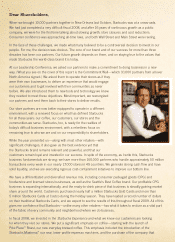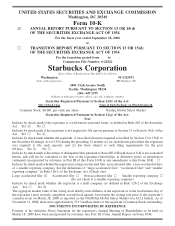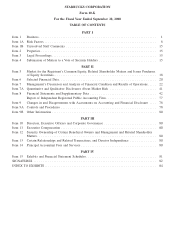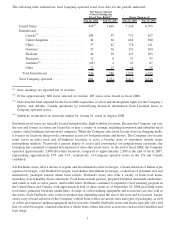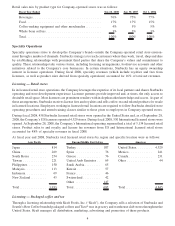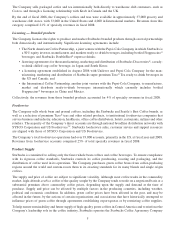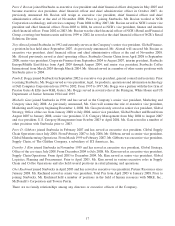Starbucks 2008 Annual Report Download - page 13
Download and view the complete annual report
Please find page 13 of the 2008 Starbucks annual report below. You can navigate through the pages in the report by either clicking on the pages listed below, or by using the keyword search tool below to find specific information within the annual report.Coffee-related accessories, including items bearing the Company’s logos and trademarks, are produced and
distributed through contracts with a number of different suppliers.
Competition
The Company’s primary competitors for coffee beverage sales are quick-service restaurants and specialty coffee
shops. In almost all markets in which the Company does business, there are numerous competitors in the specialty
coffee beverage business, and management expects this situation to continue. The Company believes that its
customers choose among specialty coffee retailers primarily on the basis of product quality, service and conve-
nience, as well as price. Starbucks has been experiencing significantly greater direct competition from large
competitors in the United States quick-service restaurant sector, some of whom have substantially greater financial,
marketing and operating resources than the Company. Starbucks also faces well-established competitors in many
International markets and increased competition in the US ready-to-drink coffee beverage market.
The Company’s whole bean coffees compete directly against specialty coffees sold through supermarkets, specialty
retailers and a growing number of specialty coffee stores. Both the Company’s whole bean coffees and its coffee
beverages compete indirectly against all other coffees on the market. Starbucks specialty operations face significant
competition from established wholesale and mail order suppliers, some of whom have greater financial and
marketing resources than the Company.
Starbucks also faces intense competition from both restaurants and other specialty retailers for prime retail locations
and qualified personnel to operate both new and existing stores.
Patents, Trademarks, Copyrights and Domain Names
The Company owns and/or has applied to register numerous trademarks and service marks in the United States and
in many additional countries throughout the world. Rights to the trademarks and service marks in the United States
are generally held by a wholly owned affiliate of the Company and are used by the Company under license. Some of
the Company’s trademarks, including Starbucks, the Starbucks logo, Frappuccino, Seattle’s Best Coffee and Tazo
are of material importance to the Company. The duration of trademark registrations varies from country to country.
However, trademarks are generally valid and may be renewed indefinitely as long as they are in use and/or their
registrations are properly maintained.
The Company owns numerous copyrights for items such as product packaging, promotional materials, in-store
graphics and training materials. The Company also holds patents on certain products, systems and designs. In
addition, the Company has registered and maintains numerous Internet domain names, including “Starbucks.com”
and “Starbucks.net.”
Research and Development
Starbucks research and development efforts are led by the Research and Development department. This team is
responsible for the technical development of food and beverage products and new equipment. The Company spent
approximately $7.2 million, $7.0 million and $6.5 million during fiscal 2008, 2007 and 2006, respectively, on
technical research and development activities, in addition to customary product testing and product and process
improvements in all areas of its business.
Seasonality and Quarterly Results
The Company’s business is subject to seasonal fluctuations, including fluctuations resulting from the holiday
season. The Company’s cash flows from operations are considerably higher in the fiscal first quarter than the
remainder of the year. This is largely driven by cash received as Starbucks Cards are purchased and loaded during
the holiday season. Since revenues from the Starbucks Card are recognized upon redemption and not when
purchased, seasonal fluctuations on the consolidated statements of earnings are much less pronounced. Quarterly
results are affected by the timing of the opening of new stores, and the Company’s growth may conceal the impact of
other seasonal influences. For these reasons, results for any quarter are not necessarily indicative of the results that
may be achieved for the full fiscal year.
7


